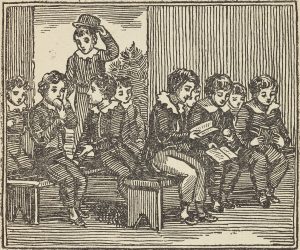August 16, 2024, by Chloe
How to do a Scoping Survey at Manuscripts and Special Collections
This is a guest post by Hannah Kane, a University of Nottingham student, who recently completed a Summer Research Placement at Manuscripts and Special Collections.
What is a Scoping Survey? A scoping survey involves identifying and checking material to establish its relevance to your research topic.
In my case, another undergraduate student and I completed a scoping survey surrounding ‘School Punishment’ from the 17th to 21st centuries as part of the Faculty of Arts, Summer Research Placement Programme. Our research will form the basis of a proposed exhibition to be shown in the Weston Gallery, Lakeside Arts.

Photograph of schoolboys from ‘The daisy, or, Cautionary stories in verse’, p.15; 1899. Briggs Collection PZ6.7 .T8
The first step is to identify your material. In our case, we were given a broad initial list by our supervisor of collection material to search that related to schools. This was helpful as our supervisor had greater knowledge of the archival material than ourselves. If you are stuck, I would recommend that you find someone who knows a little bit more about what you’re looking at to give you guidance. Next, it’s time to start using NU Search and the Manuscripts and Special Collections online catalogue. You can start broad by searching exactly what your topic is or, you could search for phrases related to it. Whatever you find you should be written down in your Excel sheet or on any other software to keep track of your research.
The second step is to check your identified material. This involves ordering the material to the Reading Room using the order slips. On the slip you will need to write the reference of your material, the title, your name, reader number and the date you want to receive the material. Once you’ve filled all of those in, hand the slips in at the desk and wait for your material to be collected. When you have your material, it’s time to start reading…
During this step, there is a risk that some of the material you have identified may not fit into the remit you’re looking at. This can be disheartening, but fear not! In the early stages of research, it is normal to find things that don’t relate to your investigation. Unfortunately, this is the nature of the task. It can be hit and miss. There may be some days where you don’t find anything relevant but others where it seems like all you read is valuable. Despite this, you must persevere. Going through lots of material requires resilience. Some titles may look promising but on closer inspection, they have nothing to do with your topic. Other times, it can be the complete opposite. You may stumble into something which on first glance doesn’t seem related, but after a read, you realise it could be key to your research.
Once you’ve finished your scoping survey, you could reflect on your findings. You could also write a summary, so anyone involved in the research after you understands your work.
I hope this has been an interesting insight into the early stages of research!
If you’d like to carry out some research of your own, feel free to visit our Reading Room – to find out more, or to book an appointment today, please contact us at mss-library@nottingham.ac.uk.
No comments yet, fill out a comment to be the first



Leave a Reply